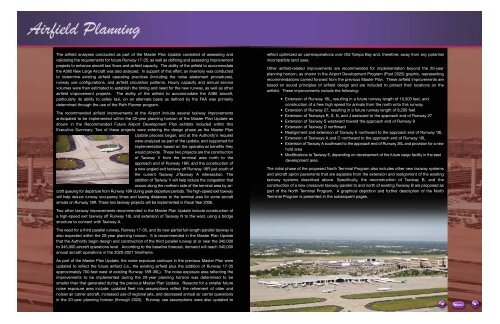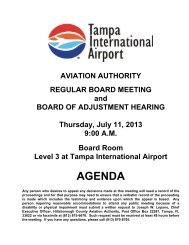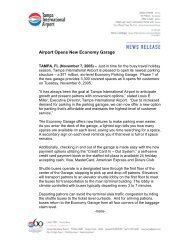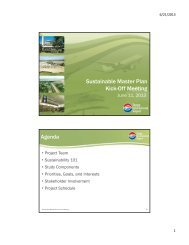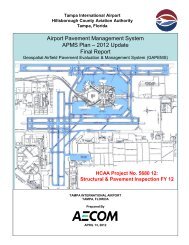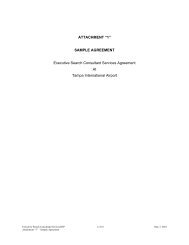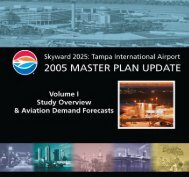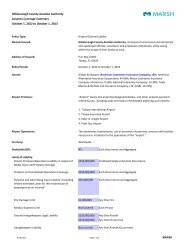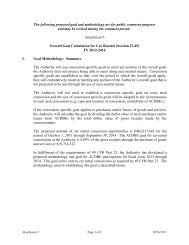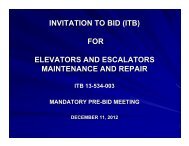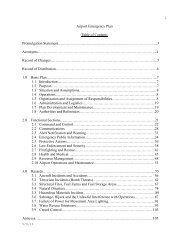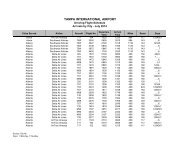Untitled - Tampa International Airport
Untitled - Tampa International Airport
Untitled - Tampa International Airport
You also want an ePaper? Increase the reach of your titles
YUMPU automatically turns print PDFs into web optimized ePapers that Google loves.
The airfield analyses conducted as part of the Master Plan Update consisted of assessing and<br />
validating the requirements for future Runway 17-35, as well as defining and assessing improvement<br />
projects to enhance aircraft taxi flows and airfield capacity. The ability of the airfield to accommodate<br />
the A380 New Large Aircraft was also analyzed. In support of this effort, an inventory was conducted<br />
to determine existing airfield operating practices (including the noise abatement procedures),<br />
runway use configurations, and airfield circulation patterns. Hourly capacity and annual service<br />
volumes were then estimated to establish the timing and need for the new runway, as well as other<br />
airfield improvement projects. The ability of the airfield to accommodate the A380 aircraft,<br />
particularly its ability to safely taxi, on an alternate basis as defined by the FAA was primarily<br />
determined through the use of the Path Planner program.<br />
The recommended airfield improvements at the <strong>Airport</strong> include several taxiway improvements<br />
anticipated to be implemented within the 20-year planning horizon of the Master Plan Update as<br />
shown in the Recommended Future <strong>Airport</strong> Development Plan exhibits included within this<br />
Executive Summary. Two of these projects were entering the design phase as the Master Plan<br />
Update process began, and at the Authority's request<br />
were analyzed as part of the update, and supported for<br />
implementation based on the operational benefits they<br />
would provide. These two projects are the construction<br />
of Taxiway V from the terminal area north to the<br />
approach end of Runway 18R, and the construction of<br />
a new angled exit taxiway off Runway 18R just south of<br />
the current Taxiway J/Taxiway A intersection. The<br />
addition of Taxiway V will help reduce the congestion that<br />
occurs along the northern side of the terminal area by aircraft<br />
queuing for departure from Runway 18R during peak departure periods. The high-speed exit taxiway<br />
will help reduce runway occupancy times and taxiing distances to the terminal area for some aircraft<br />
arrivals on Runway 18R. These two taxiway projects will be implemented in Fiscal Year 2006.<br />
reflect optimized air carrieroperations over Old <strong>Tampa</strong> Bay and, therefore, away from any potential<br />
incompatible land uses.<br />
Other airfield-related improvements are recommended for implementation beyond the 20-year<br />
planning horizon, as shown in the <strong>Airport</strong> Development Program (Post 2025) graphic, representing<br />
recommendations carried forward from the previous Master Plan. These airfield improvements are<br />
based on sound principles of airfield design and are included to protect their locations on the<br />
airfield. These improvements include the following:<br />
• Extension of Runway 18L, resulting in a future runway length of 10,500 feet, and<br />
construction of a hew high speed for arrivals from the north onto this runway.<br />
• Extension of Runway 27, resulting in a future runway length of 8,200 feet<br />
• Extension of Taxiways R, S, N, and J eastward to the approach end of Runway 27<br />
• Extension of Taxiway S westward toward the approach end of Runway 9<br />
• Extension of Taxiway D northward<br />
• Realignment and extension of Taxiway E northward to the approach end of Runway 18L<br />
• Extension of Taxiways A and C northward to the approach end of Runway 18L<br />
• Extension of Taxiway A southward to the approach end of Runway 36L and provision for a new<br />
hold area<br />
• Modifications to Taxiway E, depending on development of the future cargo facility in the east<br />
development area<br />
The initial phase of the proposed North Terminal Program also includes other new taxiway systems<br />
and aircraft apron pavements that are separate from the extension and realignment of the existing<br />
taxiway systems described above. Specifically, the reconstruction of Taxiway B, and the<br />
construction of a new crossover taxiway parallel to and north of existing Taxiway B are proposed as<br />
part of the North Terminal Program. A graphical depiction and further description of the North<br />
Terminal Program is presented in the subsequent pages.<br />
Two other taxiway improvements recommended in the Master Plan Update include construction of<br />
a high-speed exit taxiway off Runway 18L and extension of Taxiway N to the west, using a bridge<br />
structure to connect with Taxiway A.<br />
The need for a third parallel runway, Runway 17-35, and its new partial full-length parallel taxiway is<br />
also expected within the 20-year planning horizon. It is recommended in the Master Plan Update<br />
that the Authority begin design and construction of the third parallel runway at or near the 340,000<br />
to 345,000 aircraft operations level. According to the baseline forecast, demand will reach 340,000<br />
annual aircraft operations in the 2020-2021 timeframe.<br />
As part of the Master Plan Update, the noise exposure contours in the previous Master Plan were<br />
updated to reflect the future airfield (i.e., the existing airfield plus the addition of Runway 17-35<br />
approximately 700-feet west of existing Runway 18R-36L). The noise exposure area reflecting the<br />
improvements to be implemented during the 20-year planning horizon was determined to be<br />
smaller than that generated during the previous Master Plan Update. Reasons for a smaller future<br />
noise exposure area include: updated fleet mix assumptions reflect the retirement of older and<br />
noisier air carrier aircraft, increased use of regional jets, and decreased annual air carrier operations<br />
in the 20-year planning horizon (through 2025). Runway use assumptions were also updated to


